Public Spaces as Knowledgescapes: Understanding the Relationship between the Built Environment and Creative Encounters at Dutch University Campuses and Science Parks
Abstract
1. Introduction
2. Literature Review
2.1. Spatial Affordances for Creativity of University Campuses
2.2. Public Spaces: The Interface between Perceptions and Built Environment Features
- (1)
- For the organization of urban functions, a campus has to provide a mix of sports, research, residential and various academic activities.
- (2)
- Public spaces are reinforced by the appropriate proximity of buildings (density) and the juxtaposition of activities that complement one another (diversity).
- (3)
- Open and semi-public, indoor and outdoor social spaces should be scattered throughout the overall framework of the campus (not just at the campus centre), such as lounges in the halls of residence, meeting spaces in the lobbies of buildings, and outdoor sitting areas. This guarantees informal settings that facilitate interactions, including sitting opportunities, trees, shade and shelter, cafés or dining halls in various places on campus.
- (4)
- The availability of natural features, such as water and green areas, may improve one’s mental status through creating opportunities for recreation and relaxation, and promoting social well-being as well as positive physical and mental health benefits.
3. Materials and Methods
3.1. Case Studies
3.1.1. Amsterdam Inner-City Campus and Science Park
3.1.2. Utrecht Inner-City Campus and Science Park
3.2. Volunteered Geographic Information (VGI) and Spatial Analysis
Data Preparation and Analysis
3.3. The Interface between Mapped Perceptions and Built-Environment Features
3.4. Differences and Similarities between Public Spaces of Inner-City Campuses and Science Parks
4. Results and Discussion
4.1. Perceptions of Creative Encounters throughout Campus Public Spaces
4.2. The Proximity between High-Value Cells and Characteristics of the Built Environment
4.2.1. Amsterdam Inner-City Campuses and Science Park
4.2.2. Utrecht Inner-City Campus and Science Park
4.3. Differences and Similarities of Creative Encounters and Public Spaces at Inner-City Campuses and Science Parks
5. Conclusions
Author Contributions
Funding
Conflicts of Interest
References
- Hugginsa, R.; Johnstona, A.; Steffensonb, R. Universities, Knowledge Networks and Regional Policy. Cambridge J. Reg. Econ. Soc. 2008, 1, 321–340. [Google Scholar] [CrossRef]
- Deiaco, E.; Hughes, A.; McKelvey, M. Universities as Strategic Actors in the Knowledge Economy. Cambridge J. Econ. 2012, 36, 525–541. [Google Scholar] [CrossRef]
- Addie, J.P.D.; Keil, R.; Olds, K. Beyond Town and Gown: Universities, Territoriality and the Mobilization of New Urban Structures in Canada. Territ. Polit. Gov. 2015, 3, 27–50. [Google Scholar] [CrossRef]
- Glaeser, E.L.; Maré, D.C. Cities and Skills. J. Labor Econ. 2001, 19, 316–342. [Google Scholar] [CrossRef]
- Brown, B.B.; Perkins, D.D. Disruptions in place attachment. In Place Attachment; Springer: Boston, MA, USA, 1992; pp. 279–304. [Google Scholar]
- Williams, D.; Patterson, M.E. Place, Leisure and Well-Being. In Sense of Place, Health and Quality of Life; Eyles, J., Williams, A., Eds.; Ashgate Publishing Limited: Aldershot, UK, 2008; pp. 105–119. [Google Scholar]
- Atkinson, S.; Fuller, S. Wellbeing and Place; Ashgate Publishing: Farnham, UK, 2012. [Google Scholar]
- Dolan, P.; Metcalfe, R. The Relationship between Innovation and Subjective Wellbeing. Res. Policy 2012, 41, 1489–1498. [Google Scholar] [CrossRef]
- Zordan, M.; Talamini, G.; Villani, C. The Association between Ground Floor Features and Public Open Space Face-to-Face Interactions: Evidence from Nantou Village, Shenzhen. Int. J. Environ. Res. Public Health 2019, 16, 4934. [Google Scholar] [CrossRef] [PubMed]
- Francis, J.; Giles-Corti, B.; Wood, L.; Knuiman, M. Creating Sense of Community: The Role of Public Space. J. Environ. Psychol. 2012, 32, 401–409. [Google Scholar] [CrossRef]
- Sternberg, R.J.; Lubart, T.I. An Investment Theory of Creativity and Its Development. Hum. Dev. 1991, 34, 1–31. [Google Scholar] [CrossRef]
- Meusburger, P. Milieus of Creativity: The Role of Places, Environments, and Spatial Contexts. In Milieus of Creativity; Springer Science+Business Media: Dordrecht, The Netherlands, 2009. [Google Scholar] [CrossRef]
- Stevens, Q. Creative Milieux: How Urban Design Nurtures Creative Clusters. J. Urban Des. 2015. [Google Scholar] [CrossRef]
- Wood, S.; Dovey, K. Creative Multiplicities: Urban Morphologies of Creative Clustering. J. Urban Des. 2015, 20, 52–74. [Google Scholar] [CrossRef]
- Amabile, T.M. The Social Psychology of Creativity: A Componential Conceptualization. J. Pers. Soc. Psychol. 1983, 45, 357–376. [Google Scholar] [CrossRef]
- Amabile, T.M.; Conti, R.; Coon, H.; Lazenby, J.; Herron, M. Assessing the Work Environment for Creativity. Acad. Manag. J. 1996, 39, 1154–1184. [Google Scholar]
- Csikszentmihalyi, M. Society, culture, and person: A systems view of creativity. In The Nature of Creativity: Contemporary Psychological Perspectives; Cambridge University Press: New York, NY, USA, 1988; pp. 325–339. [Google Scholar]
- Csikszentmihalyi, M. Implications of a systems perspective for the study of creativity. In Handbook of Creativity; Cambridge University Press: Cambridge, UK, 1999. [Google Scholar]
- Sailer, K. Creativity as Social and Spatial Process. Facilities 2011, 29, 6–18. [Google Scholar] [CrossRef]
- Gibson, J.J. The Ecological Approach to Visual Perception; Houghton Mifflin: Boston, MA, USA, 1979. [Google Scholar]
- Chemero, A. An Outline of a Theory of Affordances. Ecol. Psychol. 2003. [Google Scholar] [CrossRef]
- Kyttä, M.; Oliver, M.; Ikeda, E.; Ahmadi, E.; Omiya, I.; Laatikainen, T. Children as Urbanites: Mapping the Affordances and Behavior Settings of Urban Environments for Finnish and Japanese Children. Child. Geogr. 2018, 16, 319–332. [Google Scholar] [CrossRef]
- Garau, C.; Annunziata, A.; Yamu, C. A Walkability Assessment Tool Coupling Multi-Criteria Analysis and Space Syntax: The Case Study of Iglesias, Italy. Eur. Plan. Stud. 2020. [Google Scholar] [CrossRef]
- Heft, H. Affordances and the perception of landscape. In Innovative Approaches to Researching Landscape and Health; Routledge: Oxford, UK, 2010; pp. 9–32. [Google Scholar]
- Glǎveanu, V.P. What Can Be Done with an Egg? Creativity, Material Objects, and the Theory of Affordances. J. Creat. Behav. 2012, 46, 192–208. [Google Scholar] [CrossRef]
- De Silva, M.J.; McKenzie, K.; Harpham, T.; Huttly, S.R.A. Social Capital and Mental Illness: A Systematic Review. J. Epidemiol. Community Health 2005, 59, 619–627. [Google Scholar] [CrossRef]
- Weijs-Perrée, M.; Dane, G.; van den Berg, P.; van Dorst, M. A Multi-Level Path Analysis of the Relationships between the Momentary Experience Characteristics, Satisfaction with Urban Public Spaces, and Momentary- and Long-Term Subjective Wellbeing. Int. J. Environ. Res. Public Health 2019, 16, 3621. [Google Scholar] [CrossRef]
- Hajrasoulih, A.; Del Rio, V.; Francis, J.; Edmondson, J. Urban form and mental wellbeing: Scoping a theoretical framework for action. J. Urban Spaces Ment. Health 2018, 5. Available online: https://www.urbandesignmentalhealth.com/journal-5---urban-form-and-mental-wellbeing.html# (accessed on 9 October 2020).
- Hillier, B. The fourth sustainability, creativity: Statistical associations and credible mechanisms. In Complexity, Cognition, Urban Planning and Desig; Springer: Cham, Switzerland, 2016; pp. 75–92. [Google Scholar]
- Meusburger, P. Knowledge Environments in Universities. Hung. Geogr. Bull. 2015, 64, 265–279. [Google Scholar] [CrossRef]
- Curvelo Magdaniel, F.T.d.J.; Den Heijer, A.C.; Curvelo Magdaniel, F.T.; De Jonge, H. The Locations of Innovation Described through Thirty-Nine Tech-Campuses. Compet. Rev. 2018, 28, 58–74. [Google Scholar]
- Da Silva, L.C.; Heitor, T.V.; Calvo-Sotelo, P.C. How Exclusive Do We Want to Be? Exploring the University Realm in the Contemporary Urban Territory. In Proceedings of the 11th International Space Syntax Symposium, SSS, Lisbon, Portugal, 3–7 July 2017; Available online: http://www.11ssslisbon.pt/proceedings/ (accessed on 9 October 2020).
- Hajrasouliha, A.H. Master-Planning the American Campus: Goals, Actions, and Design Strategies. Urban Des. Int. 2017, 22, 363–381. [Google Scholar] [CrossRef]
- Hajrasouliha, A. Campus Score: Measuring University Campus Qualities. Landsc. Urban Plan. 2017, 158, 166–176. [Google Scholar] [CrossRef]
- Pancholi, S.; Yigitcanlar, T.; Guaralda, M. Public Space Design of Knowledge and Innovation Spaces: Learnings from Kelvin Grove Urban Village, Brisbane. J. Open Innov. Technol. Mark. Complex. 2015, 1. [Google Scholar] [CrossRef]
- Appel-Meulenbroek, R. Knowledge Sharing through Co-Presence: Added Value of Facilities. Facilities 2010, 28, 189–205. [Google Scholar] [CrossRef]
- Penn, A.; Desyllas, J.; Vaughan, L. The Space of Innovation: Interaction and Communication in the Work Environment. Environ. Plan. B Plan. Des. 1999, 26, 193–218. [Google Scholar] [CrossRef]
- Goodchild, M.F. Citizens as Sensors: The World of Volunteered Geography. GeoJournal 2007, 69, 211–221. [Google Scholar] [CrossRef]
- Rantanen, H.; Kahila, M. The SoftGIS Approach to Local Knowledge. J. Environ. Manag. 2009, 90, 1981–1990. [Google Scholar] [CrossRef]
- Brown, G.G.; Reed, P. Social Landscape Metrics: Measures for Understanding Place Values from Public Participation Geographic Information Systems (PPGIS). Landsc. Res. 2012, 37, 73–90. [Google Scholar] [CrossRef]
- Brown, G.; Kyttä, M. Key Issues and Research Priorities for Public Participation GIS (PPGIS): A Synthesis Based on Empirical Research. Appl. Geogr. 2014, 46. [Google Scholar] [CrossRef]
- Swearingen White, S. Sustainable Campuses and Campus Planning: Experiences from a Classroom Case Study at the University of Kansas. Int. J. Sustain. High. Educ. 2003, 4, 344–356. [Google Scholar] [CrossRef]
- Carmona, M. Contemporary Public Space, Part Two: Classification. J. Urban Des. 2010, 15, 157–173. [Google Scholar] [CrossRef]
- Carmona, M. Re-Theorising Contemporary Public Space: A New Narrative and a New Normative. J. Urban. 2015, 8, 373–405. [Google Scholar] [CrossRef]
- Wolf, I.D.; Brown, G.; Wohlfart, T. Applying Public Participation GIS (PPGIS) to Inform and Manage Visitor Conflict along Multi-Use Trails. J. Sustain. Tour. 2018, 26, 470–495. [Google Scholar] [CrossRef]
- Boden, M.A. The Creative Mind: Myths and Mechanism; Routledge: London, UK, 2004. [Google Scholar]
- Withagen, R.; de Poel, H.J.; Araújo, D.; Pepping, G.J. Affordances Can Invite Behavior: Reconsidering the Relationship between Affordances and Agency. New Ideas Psychol. 2012, 30, 250–258. [Google Scholar] [CrossRef]
- Helbrecht, I. Bare Geographies in Knowledge Societies - Creative Cities as Text and Piece of Art: Two Eyes, One Vision. Built Environ. 2004, 30, 194–203. [Google Scholar] [CrossRef]
- Evers, H.D.; Gerke, S.; Menkhoff, T. Knowledge Hubs and Knowledge Clusters: A Knowledge Architecture for Development. Beyond Knowl. Trap Dev. Asia’s Knowl.-Based Econ. 2011. [Google Scholar] [CrossRef]
- Matthiesen, U. KnowledgeScapes: A New Conceptual Approach and Selected Empirical Findings from Recent Research on Knowledge Milieus and Knowledge Networks. Disp Plan. Rev. 2009, 177, 10–28. [Google Scholar] [CrossRef]
- Rantisi, N.M.; Leslie, D.; Christopherson, S. Placing the Creative Economy: Scale, Politics, and the Material. Environ. Plan. A 2006, 38, 1789–1797. [Google Scholar] [CrossRef]
- Lefebvre, H.; Nicholson-Smith, D. The Production of Space; Blackwell: Oxford, UK, 1991. [Google Scholar]
- Tuan, Y.-F. Space and Place: The Perspective of Experience; University of Minnesota Press: Minneapolis, MN, USA, 1977. [Google Scholar]
- Cresswell, T.; Malden, M.A. Place: A Short Introduction; Wiley-Blackwell Publishing: Hoboken, NJ, USA, 2004. [Google Scholar]
- Canter, D. The Psychology of Place; London the Architectural Press Ltd.: London, UK, 1977. [Google Scholar]
- Rowles, G.D. Place in Occupational Science: A Life Course Perspective on the Role of Environmental Context in the Quest for Meaning. J. Occup. Sci. 2008, 15, 127–135. [Google Scholar] [CrossRef]
- Canter, D. Putting situations in their place: Foundations for a bridge between social and environmental psychology. In Social Behaviour in Context; Furmham, A., Ed.; Allyn & Bacon: London, UK, 1986; pp. 208–239. [Google Scholar]
- Arendt, H. The Human Condition; University of Chicago Press: Chicago, IL, USA, 2013. [Google Scholar]
- Carr, S. Public Space; Cambridge University Press: Cambridge, UK, 1992. [Google Scholar]
- Worpole, K.; Greenhalgh, L. The Freedom of the City; Demos: London, UK, 1996. [Google Scholar]
- Oldenburg, R. Chapter 2: The Character of Third Places. In The Great Good Place: Cafes, Coffee Shops, Community Centers, Beauty Parlors, General Stores, Bars, Hangouts and How They Get You Through the Day. Urban Design Reader; Routledge: London, UK, 2007; pp. 20–42. [Google Scholar]
- Altman, I.; Zube, E.H. (Eds.) Public Places and Spaces; Springer Science & Business Media: Berlin/Heidelberg, Germany, 2012; Volume 10. [Google Scholar]
- Mehta, V. Evaluating Public Space. J. Urban Des. 2014, 19, 53–88. [Google Scholar] [CrossRef]
- Mehta, V. Lively Streets: Determining Environmental Characteristics to Support Social Behavior. J. Plan. Educ. Res. 2007, 27, 165–187. [Google Scholar] [CrossRef]
- Whyte, W.H. The Social Life of Small Urban Spaces; The Conservation Foundation: Washington, DC, USA, 1980. [Google Scholar]
- Dober, R.P. Campus Design; John Wiley & Sons: Hoboken, NJ, USA, 1992. [Google Scholar]
- Dober, R.P. Campus Landscape: Functions, Forms, Features; John Wiley & Sons: Hoboken, NJ, USA, 2000. [Google Scholar]
- Strange, C.C.; Banning, J.H. Educating by Design: Creating Campus Learning Environments That Work; Jossey-Bass: San Francisco, CA, USA, 2001. [Google Scholar]
- Strange, C.C.; Banning, J.H. Designing for Learning: Creating Campus Environments for Student Success; John Wiley & Sons: Hoboken, NJ, USA, 2015. [Google Scholar]
- Kenney, D.R.; Dumont, R.; Kenney, G. Mission and Place: Strengthening Learning and Community through Campus Design; Praeger Publishers: Westport, CT, USA, 2005. [Google Scholar]
- Lau, S.S.Y.; Yang, F. Introducing Healing Gardens into a Compact University Campus: Design Natural Space to Create Healthy and Sustainable Campuses. Landsc. Res. 2009, 34, 55–81. [Google Scholar] [CrossRef]
- Zeng, C.; Lyu, B.; Deng, S.; Yu, Y.; Li, N.; Lin, W.; Li, D.; Chen, Q. Benefits of a Three-Day Bamboo Forest Therapy Session on the Physiological Responses of University Students. Int. J. Environ. Res. Public Health 2020, 17, 3238. [Google Scholar] [CrossRef] [PubMed]
- Talen, E. The Geospatial Dimension in Urban Design. J. Urban Des. 2011, 16, 127–149. [Google Scholar] [CrossRef]
- Magdaniel, F.C. Technology Campuses and Cities: A Study on the Relation between Innovation and the Built Environment at the Urban Area Level; TU Delft Open: Delft, The Netherlands, 2016. [Google Scholar]
- Cannas da Silva, L.; Heitor, T.V. Campuses as Sustainable Urban Engines: A Morphological Approach to Campus Social Sustainability. In Handbook of Theory and Practice of Sustainable Development in Higher Education; Springer: Cham, Swutzerland, 2017; pp. 259–276. [Google Scholar]
- den Heijer, A.C.; Curvelo Magdaniel, F.T.J. Campus–City Relations: Past, Present, and Future. In Geographies of the University; Springer: Chan, Switzerland, 2018; pp. 439–459. [Google Scholar]
- Geografische Open-Data GIS Bestanden. Available online: https://www.imergis.nl/htm/opendata.htm (accessed on 7 July 2020).
- den Heijer, A.C.; Arkesteijn, M.H.; de Jong, P.; de Bruyne, E. Campus NL: Investeren in de Toekomst. Available online: http://resolver.tudelft.nl/uuid:3a2d0cfd-6ed0-4f7d-bc88-b2253641ebb6 (accessed on 9 October 2020).
- Bott, H. City and University—An Architect’s Notes on an Intriguing Spatial Relationship. In Geographies of the University. Knowledge and Space; Springer: Cham, Switzerland, 2018. [Google Scholar]
- Hashimshony, R.; Haina, J. Designing the University of the Future. In The Translational Design of Universities; Brill, Sense Publishers: Leiden, The Netherlands, 2019; pp. 51–70. [Google Scholar]
- den Heijer, A. Managing the University Campus in an Urban Perspective: Theory, Challenges and Lessons from Dutch Practice. Corp. Cities Envsioning Corp. Real Estate Urban Future 2008. Available online: http://residentiallivinglab.org/wp-content/uploads/2017/01/Paper02_denHeijer.pdf (accessed on 9 October 2020).
- den Heijer, A. Managing the University Campus: Exploring Models for the Future and Supporting Today’s Decisions. CELE Exch. 2012. Available online: http://resolver.tudelft.nl/uuid:4082874c-a351-4fd1-bdc6-02007273b86b (accessed on 9 October 2020).
- Annerstedt, J. Science Parks and High-Tech Clustering. In International Handbook on Industrial Policy; Edward Elgar Publishing: Cheltenham, UK, 2006; pp. 279–297. [Google Scholar]
- Ng, W.K.B.; Appel-Meulenbroek, R.; Cloodt, M.; Arentze, T. Towards a Segmentation of Science Parks: A Typology Study on Science Parks in Europe. Res. Policy 2019, 48, 719–732. [Google Scholar] [CrossRef]
- European Commision. Setting Up, Managing and Evaluating EU Science and Technology Parks. Dir. Gen. Reg. Urban Policy 2006. Available online: https://www.ipd.gu.se/digitalAssets/759/759844_Europeans_and_their_Languages_-_EC_2006.pdf (accessed on 9 October 2020).
- Turner, P.V. Campus: An American Planning Tradition; The Architectural History Foundation/MIT Press Series 7; Architectural History Foundation: New York, NY, USA, 1984. [Google Scholar]
- Coulson, J.; Roberts, P.; Taylor, I. University Planning and Architecture: The Search for Perfection; Routledge: London, UK, 2010. [Google Scholar]
- Mulder, D. Roeterseiland. Amsterdamsebinnenstad.nl. 2010. Available online: https://www.amsterdamsebinnenstad.nl/binnenstad/241/roeterseiland.html (accessed on 7 July 2020).
- Gemeente Amsterdam. Bestemmingsplan Eerste Partiele Herziening Science Park Amsterdam. 2014. Available online: http://ftp.ruimtelijkeplannen.amsterdam.nl/DRO/plannen/NL.IMRO.0363.M1401BPGST-/NL.IMRO.0363.M1401BPGST-VG01/b_NL.IMRO.0363.M1401BPGST-VG01_tb5.pdf (accessed on 7 July 2020).
- Utrecht University. De Universiteit Utrecht Bezit Bijzonder Cultureel Erfgoed. Available online: https://www.uu.nl/organisatie/profiel/traditie-en-historie/cultureel-erfgoed (accessed on 7 July 2020).
- Utrecht University. Facts and Figures. Available online: https://www.uu.nl/en/organisation/profile/facts-and-figures (accessed on 24 March 2020).
- Utrecht University. Campus Utrecht Science Park. Available online: https://www.uu.nl/en/organisation/real-estate-and-campus/campus-utrecht-science-park/facilities/buildings-utrecht-science-park (accessed on 24 March 2020).
- Yaylali-Yildiz, B.; Spierings, B.; Çil, E. The spatial configuration and publicness of the university campus: Interaction, discovery, and display on De Uithof in Utrecht. Urban Des. Int. 2020. [Google Scholar] [CrossRef]
- Laatikainen, T.E.; Haybatollahi, M.; Kyttä, M. Environmental, Individual and Personal Goal Influences on Older Adults’ Walking in the Helsinki Metropolitan Area. Int. J. Environ. Res. Public Health 2019, 16, 58. [Google Scholar] [CrossRef]
- Kyttä, M.; Kuoppa, J.; Hirvonen, J.; Ahmadi, E.; Tzoulas, T. Perceived Safety of the Retrofit Neighborhood: A Location-Based Approach. Urban Des. Int. 2014, 19, 311–328. [Google Scholar] [CrossRef]
- Rall, E.; Hansen, R.; Pauleit, S. The Added Value of Public Participation GIS (PPGIS) for Urban Green Infrastructure Planning. Urban For. Urban Green 2019, 40, 264–274. [Google Scholar] [CrossRef]
- Samuelsson, K.; Giusti, M.; Peterson, G.D.; Legeby, A.; Brandt, S.A.; Barthel, S. Impact of Environment on People’s Everyday Experiences in Stockholm. Landsc. Urban Plan. 2018, 171, 7–17. [Google Scholar] [CrossRef]
- Poplin, A.; Yamu, C.; Rico-Gutierrez, L. Place-Making: An Approach to the Rationale behind the Location Choice of Power Places. Iowa State University Campus as Case Study. Int. Arch. Photogramm. Remote Sens. Spatial Inf. Sci. 2017. [Google Scholar] [CrossRef]
- Goodchild, M.F.; Li, L. Assuring the Quality of Volunteered Geographic Information. Spat. Stat. 2012, 1, 110–120. [Google Scholar] [CrossRef]
- Maptionnaire Developed by Mapita, Helsinki. Available online: https://maptionnaire.com/company (accessed on 9 October 2020).
- Kahila, M.; Broberg, A. Making Cities Wiser–Crowdsourcing for Better Decisions. International Federation of Surveyors. May 2017. Available online: https://fp-hid-1076751.testsider.dk/resources/monthly_articles/2017/kahila_etal_may_2017.asp (accessed on 9 October 2020).
- NWO (Netherlands Organisation for Scientific Research). De Nederlandse Gedragscode Wetenschappelijke Integriteit 2018. Justitiële Verkenn 2018. Available online: https://doi.org/10.5553/jv/016758502019045002006 (accessed on 7 July 2020).
- Regulation (EU) 2016/679 of the European Parliament and of the Council of 27 April 2016 on the protection of natural persons with regard to the processing of personal data and on the free movement of such data, and repealing Directive 95/46/EC (General Data Protection Regulation). Off. J. Eur. Union 2016, L 119. Available online: https://eur-lex.europa.eu/legal-content/EN/TXT/?uri=CELEX:32016R0679 (accessed on 7 July 2020).
- Curtis, J.W.; Shiau, E.; Lowery, B.; Sloane, D.; Hennigan, K.; Curtis, A. The Prospects and Problems of Integrating Sketch Maps with Geographic Information Systems to Understand Environmental Perception: A Case Study of Mapping Youth Fear in Los Angeles Gang Neighborhoods. Environ. Plan. B Plan. Des. 2014, 41, 251–271. [Google Scholar] [CrossRef]
- Kyttä, A.M.; Broberg, A.K.; Kahila, M.H. Urban Environment and Children’s Active Lifestyle: Softgis Revealing Children’s Behavioral Patterns and Meaningful Places. Am. J. Heal. Promot. 2012, 26, 5. [Google Scholar] [CrossRef]
- ESRI Netherlands. University of Groningen Geoportal. Available online: https://rug.maps.arcgis.com/ (accessed on 7 July 2020).
- Basisregistrate Grootschalige Topografie (BGT). Available online: https://bgtviewer.nl (accessed on 6 July 2020).
- Kadaster. TOP 10NL-digitaal topografisch bestand. Available online: https://zakelijk.kadaster.nl/digitale-kadastrale-kaart-als-open-data (accessed on 6 July 2020).
- Open Street Map (OSM). Open Street Map Foundation (OSMF). Available online: https://www.openstreetmap.org; https://wiki.osmfoundation.org/wiki/ (accessed on 6 July 2020).
- Maps Amsterdam. Available online: https://maps.amsterdam.nl/open_geodata/ (accessed on 24 March 2020).
- Van Melik, R. Changing Public Space: The Recent Redevelopment of Dutch City Squares. Ned. Geogr. Stud. 2008, 373, 1–230. [Google Scholar]
- Lee, S. Does Context Matter? Understanding the Urban Design Requirements of Successful Neighborhood Parks. Ph.D. Thesis, Arizona State University, Phoenix, AZ, USA, April 2013. [Google Scholar]
- Anna’s Tuin & Ruigte. Available online: http://annastuinenruigte.nl/ (accessed on 24 March 2020).
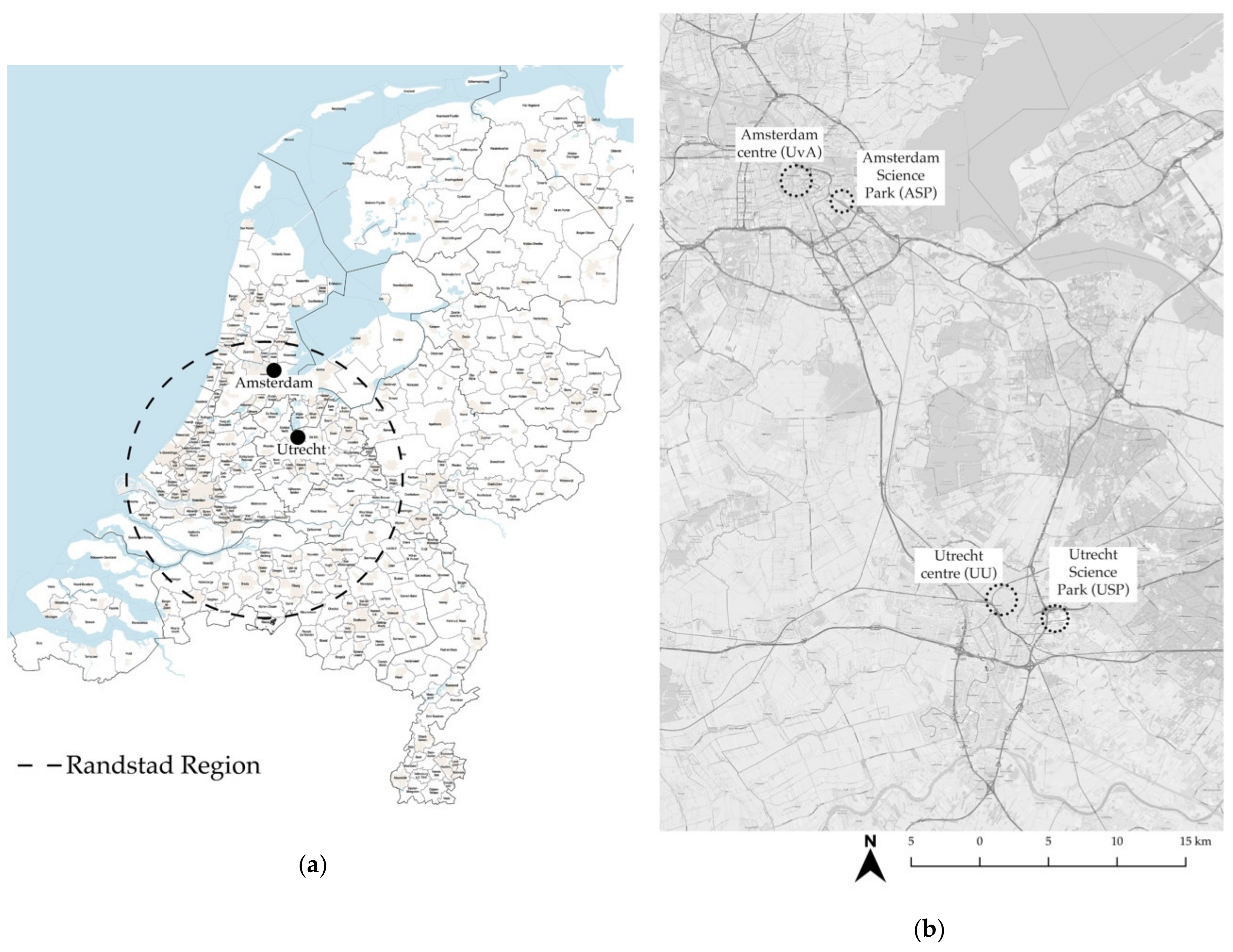


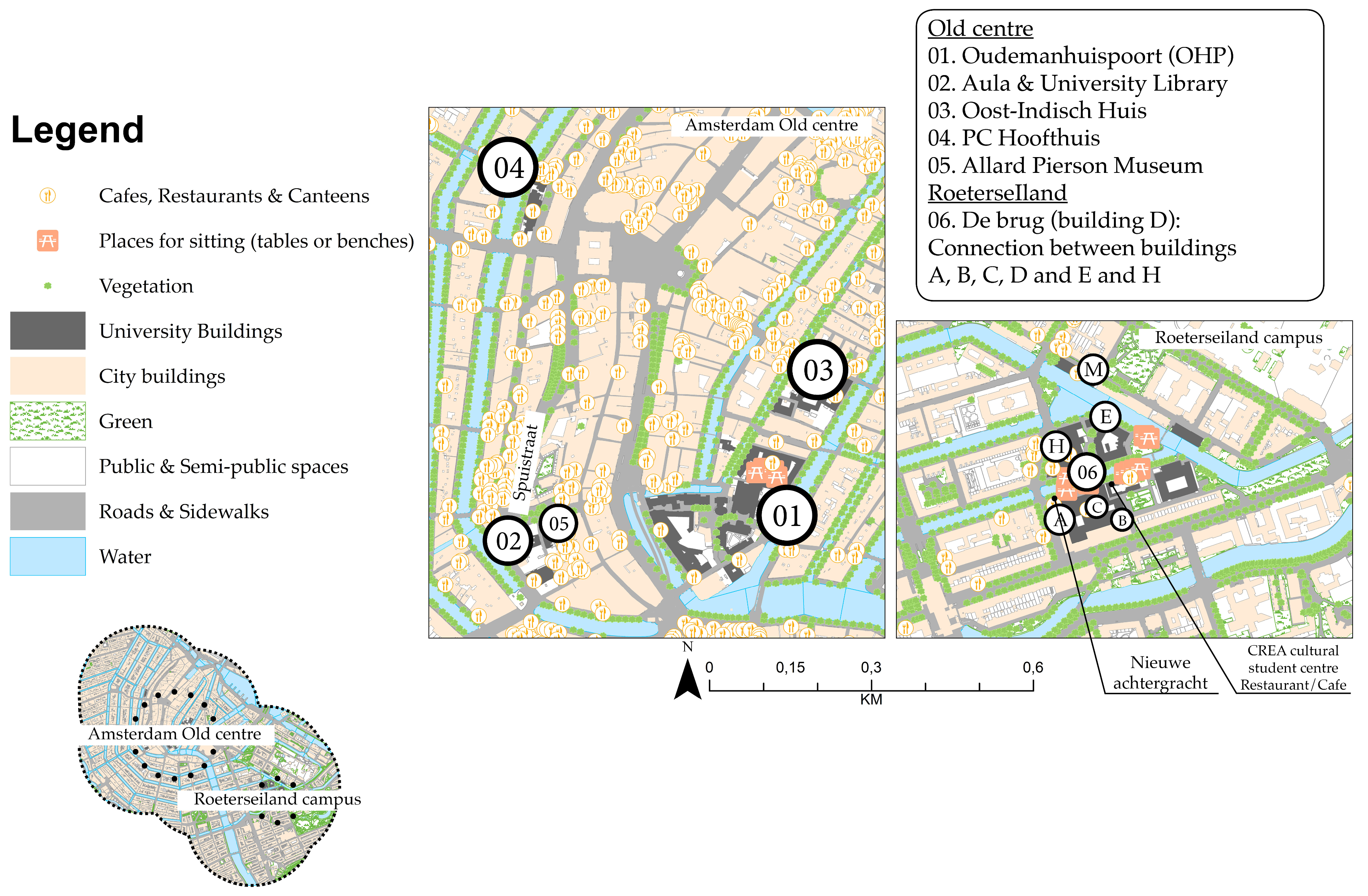
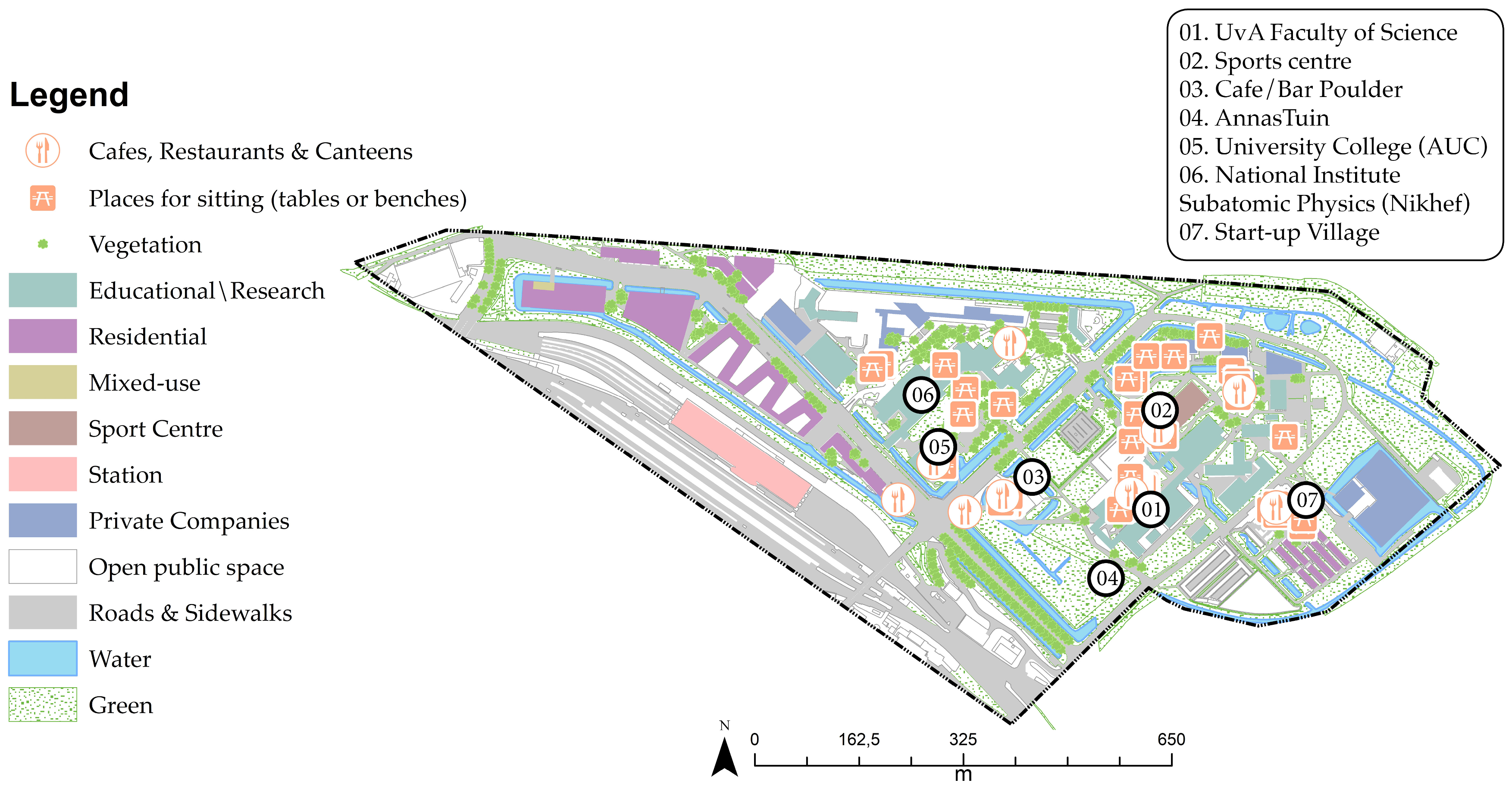
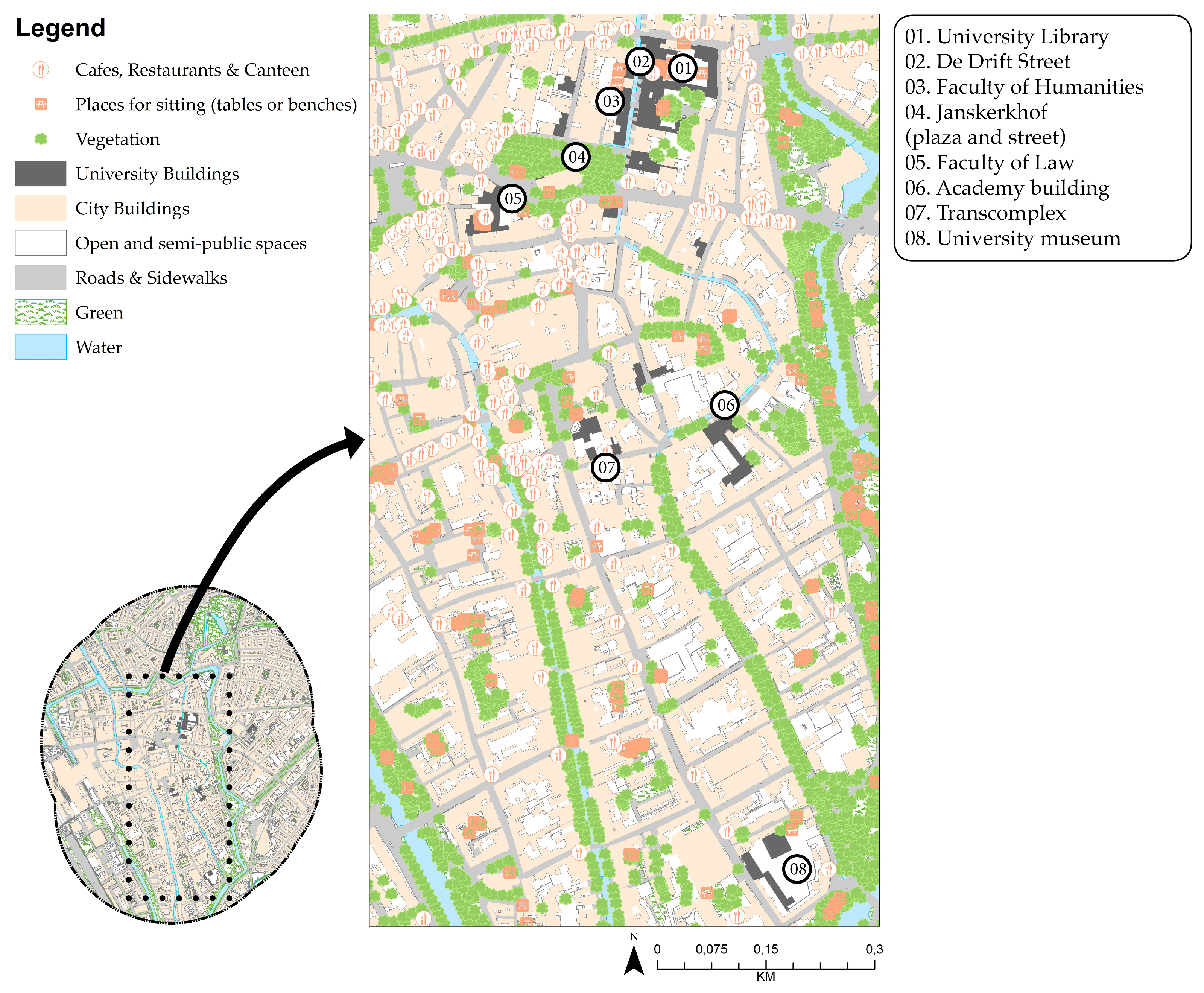
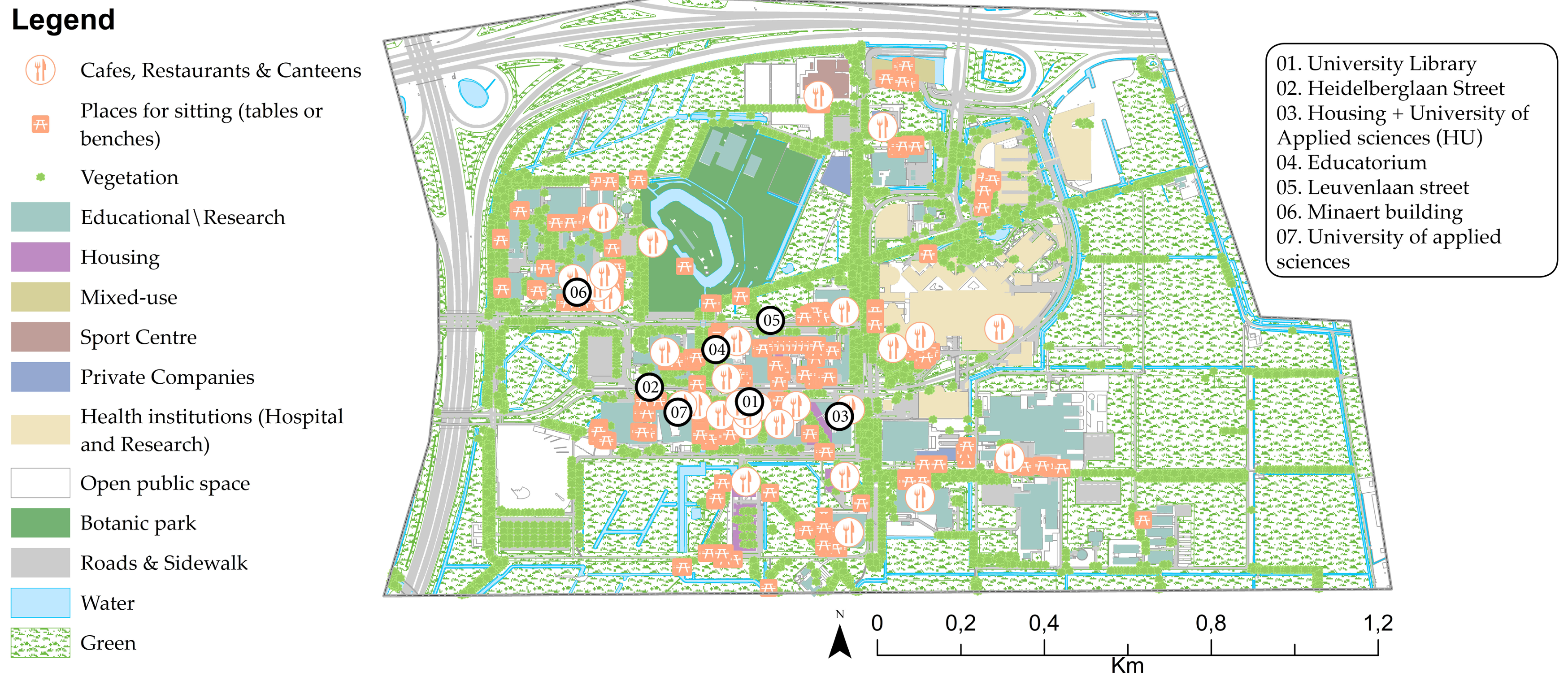
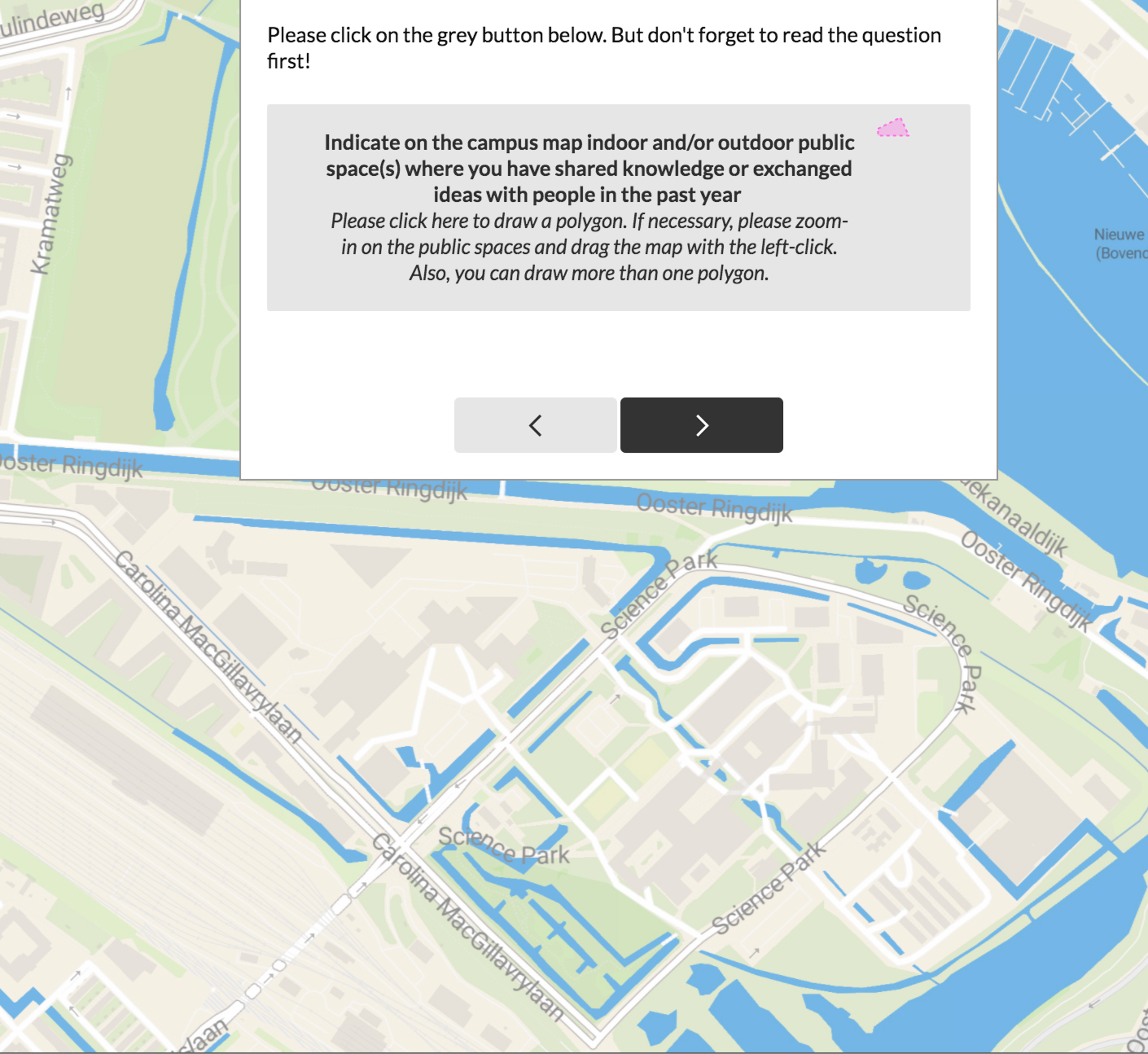
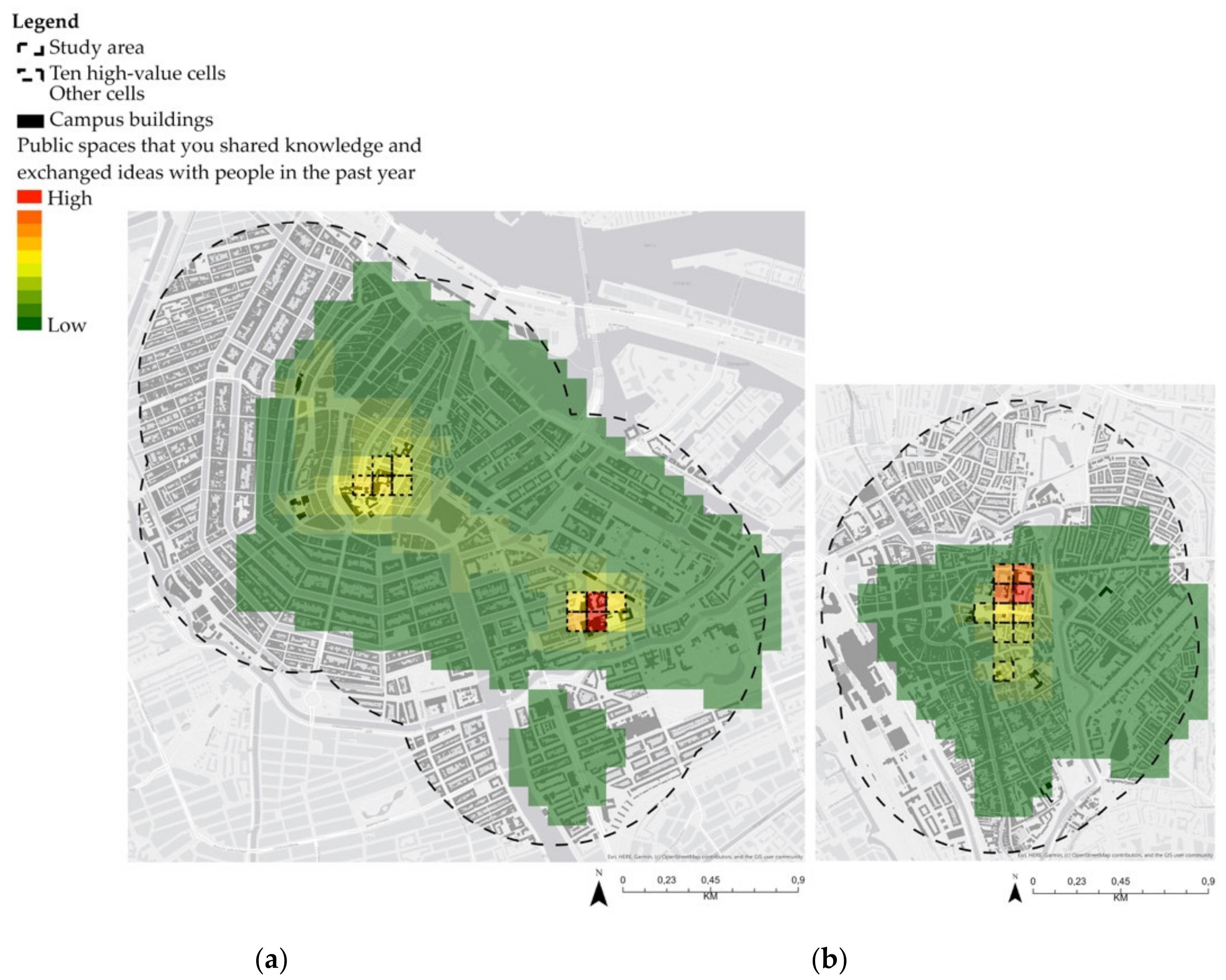
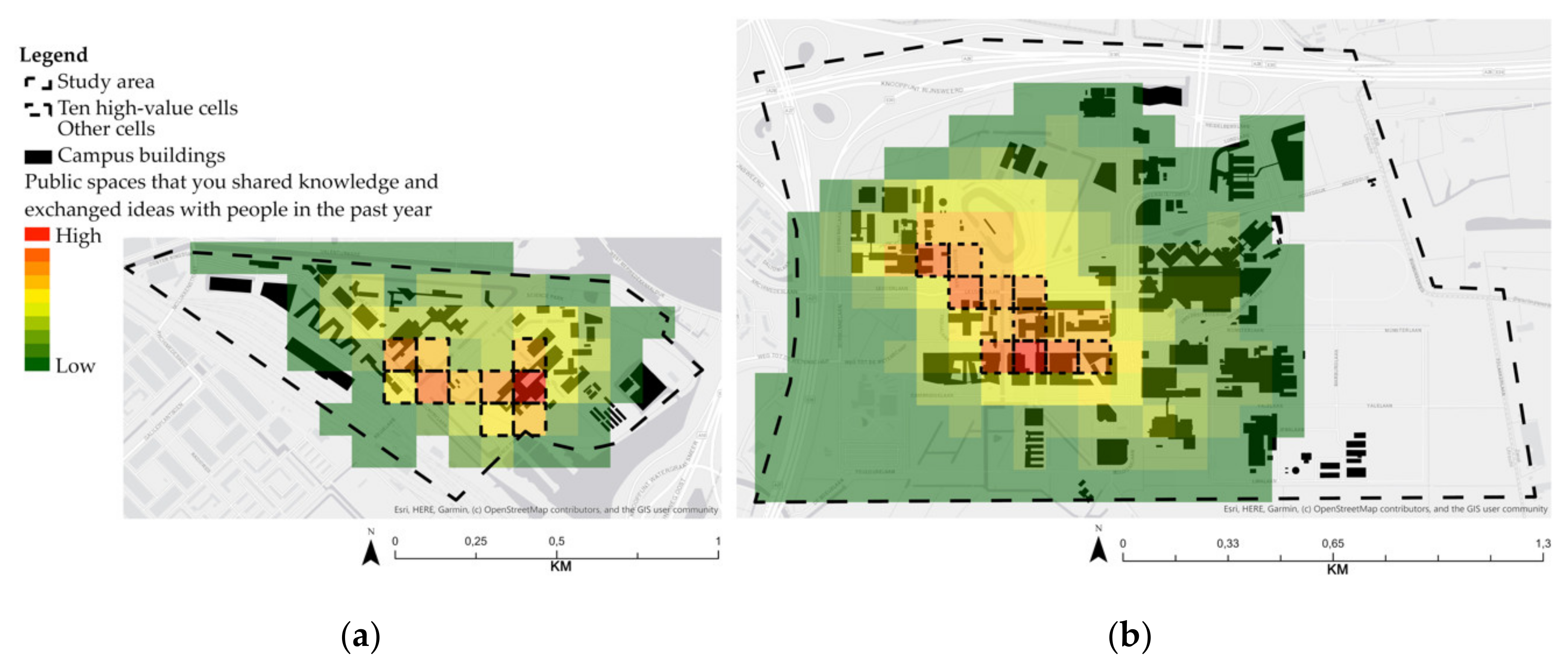

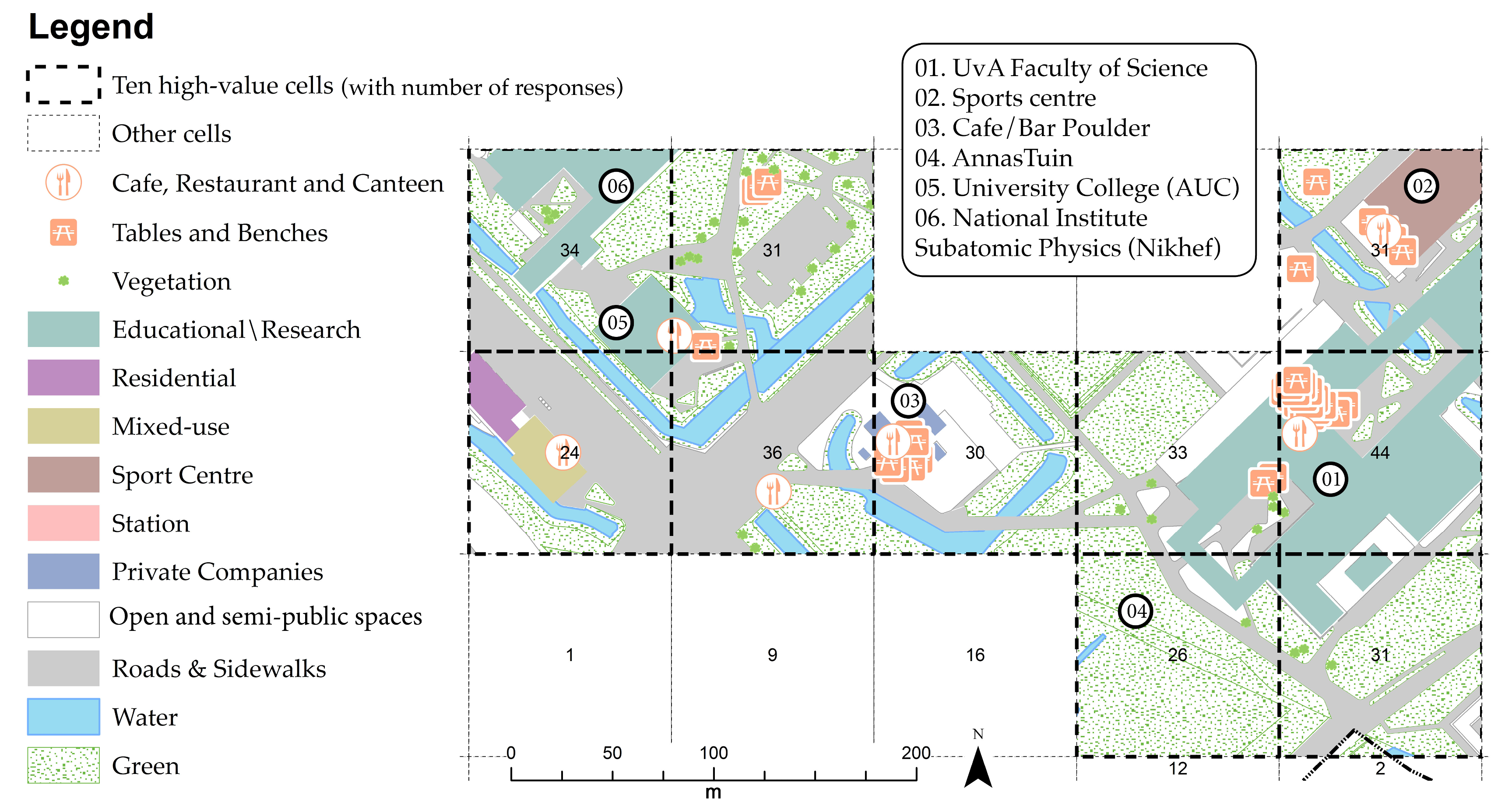
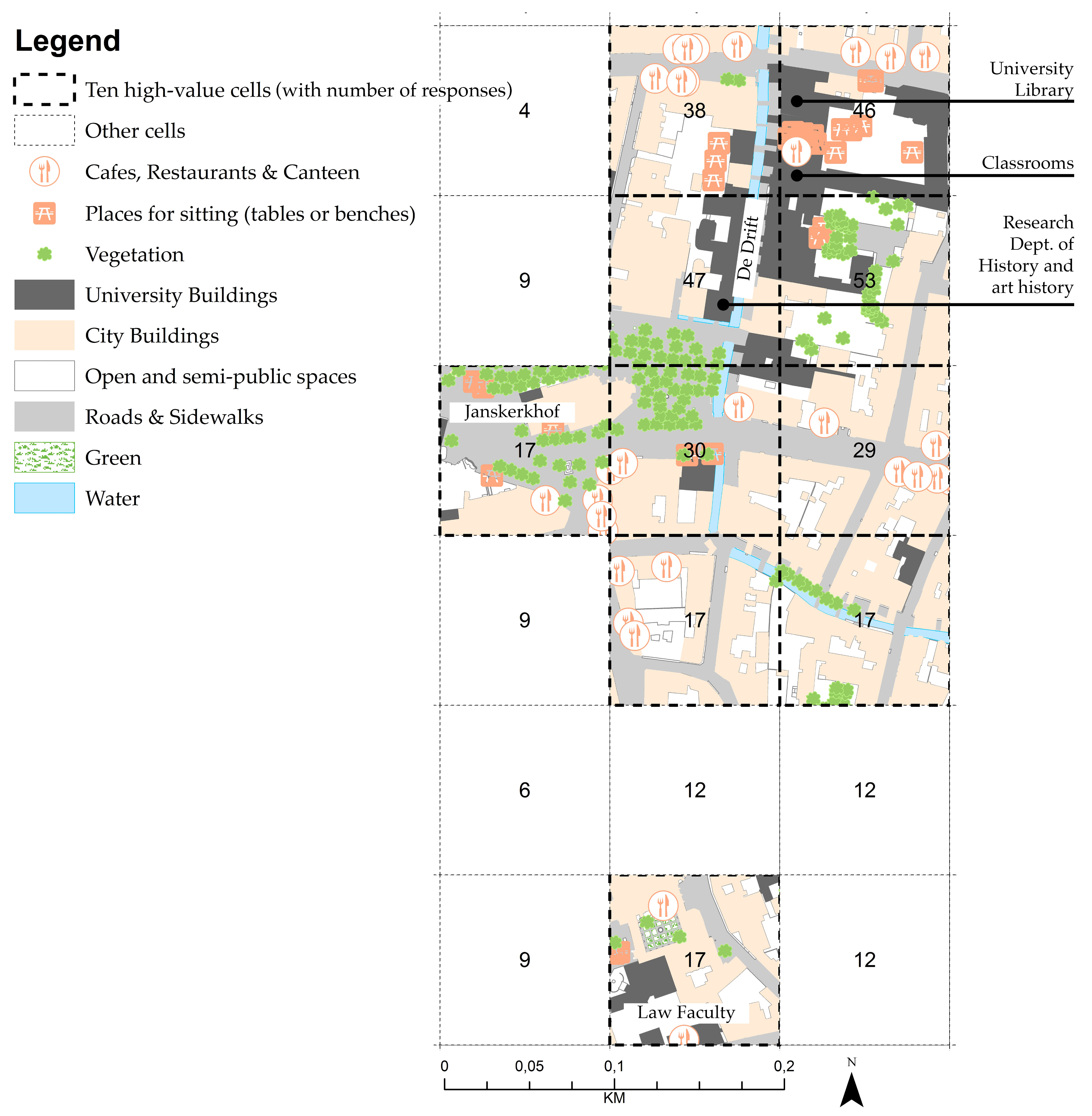
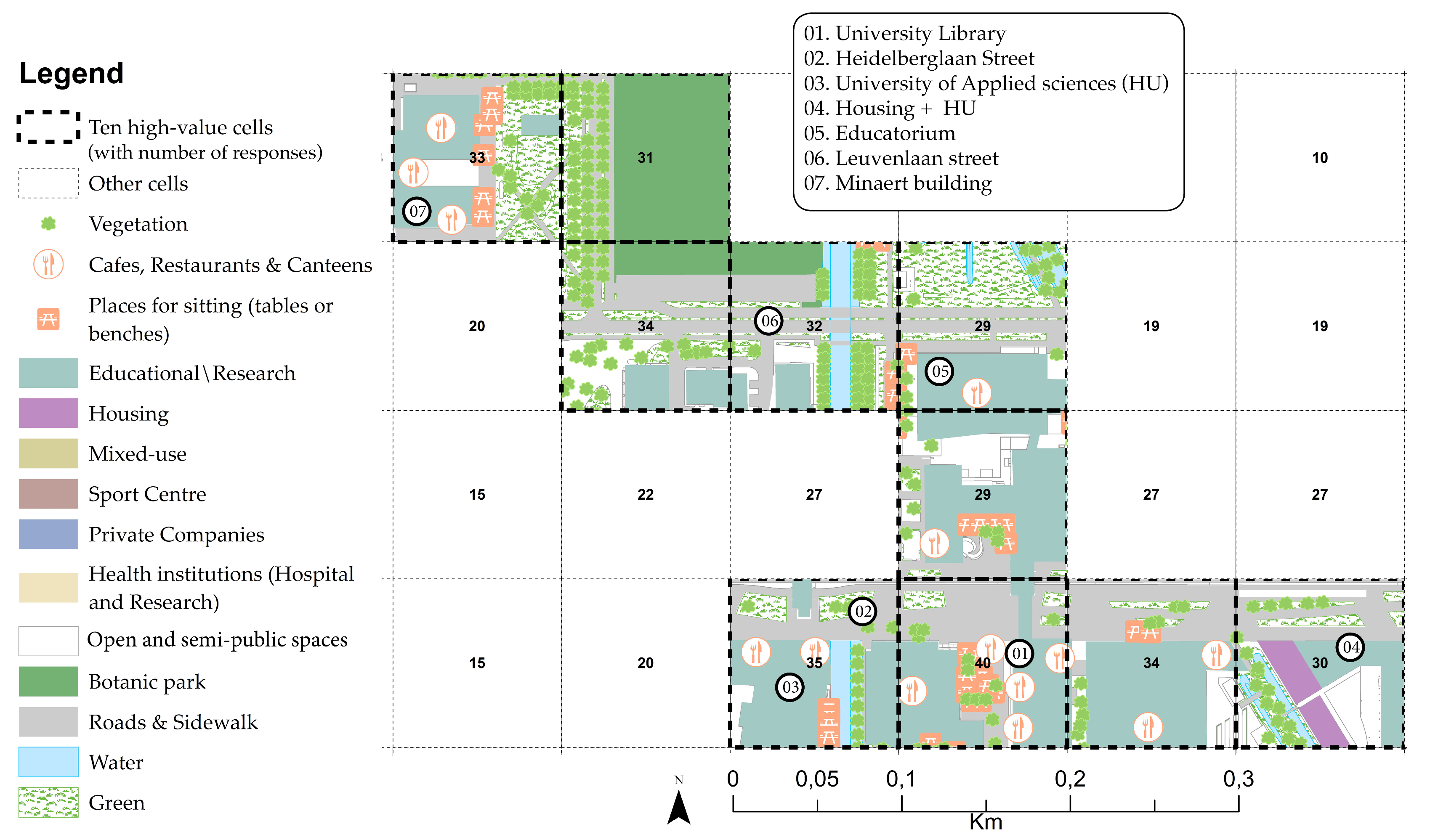
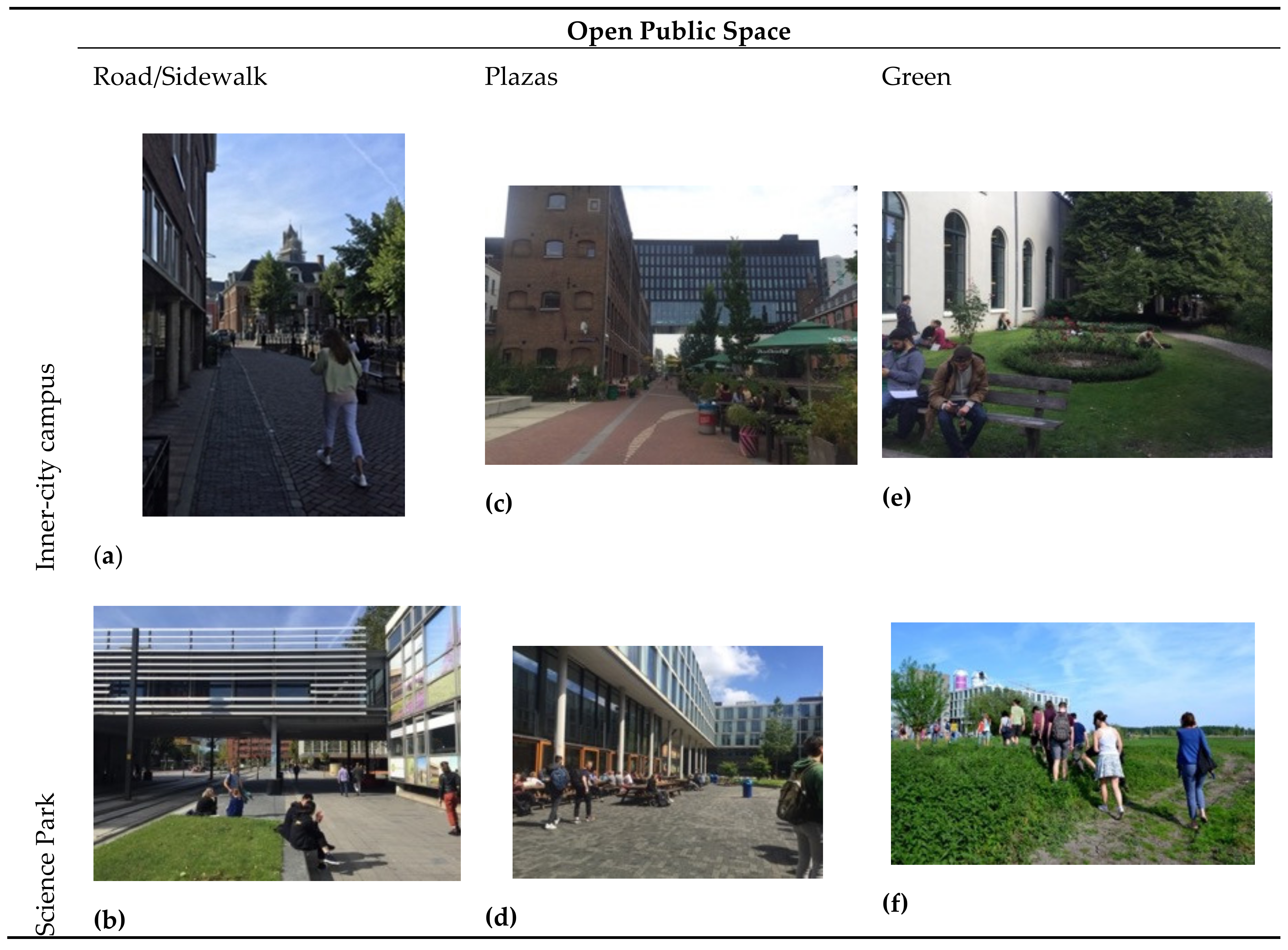

| Age | Percent | Your Role in the Science Park/Campus | Percent |
|---|---|---|---|
| 16–24 | 34.0 | Company Employee | 16.0 |
| 25–34 | 34.0 | Student | 43.7 |
| 35–44 | 18.9 | University Employee | 38.7 |
| 45–54 | 9.1 | Visitor | 1.6 |
| >55 | 4.1 | Company Employee | 16.0 |
| Total | 100.0 | 100.0 | |
| 318 respondents |
| Number of Valid Responses per Campus | Number of 100 × 100 m Cells within the Study Area | ||
|---|---|---|---|
| Science Park/Campus | Respondents | Polygon Responses | |
| Amsterdam Centre | 60 | 83 | 430 |
| Utrecht Centre | 49 | 75 | 192 |
| ASP | 105 | 166 | 68 |
| USP | 104 | 187 | 186 |
| Feature | Unit | What the Data Represents | Description of the Base Layer |
|---|---|---|---|
| Urban Functions | |||
| Buildings | Polygons | For inner city: all academic and research buildings For SPs: all buildings within the institutional boundaries. For both types of campus, this includes indoor public spaces. | BGT 1 Top10.NL 2 |
| Restaurants, canteens and cafés | Points | Points representing locations of restaurants, canteens and cafés For inner city: points within 800 m radius For SPs: points within the institutional boundaries | Top10NL OSM 3 observation |
| Public Spaces | |||
| Roads and sidewalks | Polygons | Walkable roads and sidewalks | BGT |
| Spaces between buildings (SBB) | Polygons | Open public spaces that everyone can access Semi-public: limited access via doors/gates | BGT |
| Green areas | Polygons | Urban parks, gardens and areas with grass | BGT |
| Physical Features | |||
| Sitting opportunities (tables and benches) | Points | Points representing tables and benches | BGT, OSM, observation and Amsterdam database [110] |
| Water features | Polygons | Canals and lakes | BGT |
| Vegetation | Points | Trees and small green features | BGT |
| Open Public Space | ||||
|---|---|---|---|---|
| Campus Type | Streets | Plazas | Green Areas | |
| Inner-city campus | Pedestrian-oriented design, with narrow streets and no strong differentiation between roads and sidewalks. Car circulation is often limited, allowing people to walk freely. | Squares or plazas which are part of the historic development of the city centre, surrounded by high-density buildings and streets. | Commonly found in the inner city are ‘mini/pocket parks’, which are green areas bounded by buildings. Public parks can be accessible at walking or cycling distance from these campuses. Public parks are defined as ‘publicly developed and managed open spaces, often located near the centre of a city’ [59] (p. 79). | |
| Science park (SP) | The masterplan is composed as a strictly orthogonal grid of roads. There is an orthodox separation between spaces for cars and spaces for people. | Traditional plazas are not found in science parks. They are currently being implemented. | Neighbourhood parks and community gardens may be present within SPs. Neighbourhood park: open space developed in a certain neighbourhood. Community garden: neighbourhood space designed, developed or managed by residents. | |
| Semi-Public Space | ||||
| Campus Type | Indoor | Outdoor | ||
| Inner-city campus | Consists of corridors or shared spaces, open during university hours and mostly used by people who work or study on campus. For example, community gathering spaces with tables, canteens and coffee corners. | Consists of open-air and semi-private backyards. Spaces limited by design or management policy, with access through doors or gates. These areas are mainly exclusive to university students and employees. | ||
| Science park (SP) | ||||
| Campuses | Total Polygon Responses (100%) | Responses within the Highest Cell | Location of the Highest Cell | % of Responses Based on Total Polygons |
|---|---|---|---|---|
| Amsterdam Inner-city | 83 | 35 | RI 1 campus (spaces between buildings A, B and C and E and H) | 42.1% |
| Utrecht Inner-city | 75 | 53 | De Drift (Faculty of humanities’ classrooms and backyards) | 70.6% |
| ASP | 166 | 44 | Indoor and outdoor spaces of the Faculty of sciences (UvA 2) | 26.5% |
| USP | 187 | 40 | USP University Library and Faculty of social sciences | 21.3% |
| Cell ID | High VGI Values (n) | Distance to: | |||||||||||||||
|---|---|---|---|---|---|---|---|---|---|---|---|---|---|---|---|---|---|
| Urban Functions | Physical Features | ||||||||||||||||
| Campus Buildings | Restaurant, Café or Canteen | Road and/or Sidewalk | Spaces between Buildings (SBB) | Green | Tables and Benches | Water | Vegetation | ||||||||||
| CWC 1 | DN 3 | CWC | DN | CWC | DN | CWC | DN | CWC | DN | CWC | DN | CWC | DN | CWC | DN | ||
| 97 (RI) | 35 | x 2 | x | x | x | 7 | x | x | x | ||||||||
| 125 (RI) | 32 | x | x | x | x | x | x | x | x | ||||||||
| 96 (RI) | 24 | x | x | x | x | 17 | x | x | x | ||||||||
| 124 (RI) | 21 | x | x | x | x | x | 8 | x | x | ||||||||
| 126 (RI) | 20 | x | 8 | x | x | x | x | x | x | ||||||||
| 271(OHP) | 19 | x | 15 | x | x | 36 | 35 | x | x | ||||||||
| 272(OHP) | 19 | x | 3 | x | x | x | x | x | x | ||||||||
| 273(OHP) | 18 | x | 35 | x | x | 38 | 27 | x | x | ||||||||
| 294(OHP) | 18 | x | x | x | x | 65 | 7 | x | x | ||||||||
| 295(OHP) | 18 | x | x | x | x | 82 | 35 | x | x | ||||||||
| Cell ID | High VGI Values (n) | Distance to: | |||||||||||||||
|---|---|---|---|---|---|---|---|---|---|---|---|---|---|---|---|---|---|
| Urban Functions | Physical Features | ||||||||||||||||
| Campus Buildings | Restaurant, Café or Canteen | Road and/or Sidewalk | Spaces between Buildings (SBB) | Green | Tables and Benches | Water | Vegetation | ||||||||||
| CWC 1 | DN 3 | CWC | DN | CWC | DN | CWC | DN | CWC | DN | CWC | DN | CWC | DN | CWC | DN | ||
| 22 | 44 | x 2 | x | x | x | x | x | x | x | ||||||||
| 12 | 36 | x | x | x | x | x | 2 | x | x | ||||||||
| 29 | 34 | x | 2 | x | x | x | 17 | x | x | ||||||||
| 21 | 33 | x | 10 | x | x | x | x | 5 | x | ||||||||
| 14 | 31 | x | 59 | x | x | x | 35 | x | x | ||||||||
| 30 | 31 | x | x | x | x | x | x | x | x | ||||||||
| 33 | 31 | x | x | x | x | x | x | x | 20 | ||||||||
| 20 | 20 | x | x | x | x | x | x | x | 1 | ||||||||
| 13 | 26 | x | 60 | x | x | x | 35 | x | x | ||||||||
| 18 | 24 | x | x | x | x | x | 17 | x | 10 | ||||||||
| Cell ID | High VGI Values (n) | Distance to: | |||||||||||||||
|---|---|---|---|---|---|---|---|---|---|---|---|---|---|---|---|---|---|
| Urban Functions | Physical Features | ||||||||||||||||
| Campus Buildings | Restaurant Café or Canteen | Road and/or Sidewalk | Spaces between Buildings (SBB) | Green | Tables and Benches | Water | Vegetation | ||||||||||
| CWC 1 | DN 3 | CWC | DN | CWC | DN | CWC | DN | CWC | DN | CWC | DN | CWC | DN | CWC | DN | ||
| 146 | 53 | x 2 | 25 | x | x | 34 | x | 12 | x | ||||||||
| 145 | 47 | x | 24 | x | x | x | 9 | x | x | ||||||||
| 163 | 46 | x | x | x | x | 23 | x | 5 | 1 | ||||||||
| 162 | 38 | x | x | x | x | x | x | x | x | ||||||||
| 127 | 30 | x | x | x | 20 | x | x | x | x | ||||||||
| 128 | 29 | x | x | x | x | 22 | 39 | 18 | 9 | ||||||||
| 75 | 17 | x | x | x | x | x | x | 14 | x | ||||||||
| 109 | 17 | 25 | x | x | x | 4 | 8 | x | x | ||||||||
| 110 | 17 | x | 32 | x | x | x | 18 | x | x | ||||||||
| 126 | 17 | x | x | x | x | x | x | 48 | x | ||||||||
| Cell ID | Highest VGI Values | Distance to: | |||||||||||||||
|---|---|---|---|---|---|---|---|---|---|---|---|---|---|---|---|---|---|
| Urban Functions | Physical Features | ||||||||||||||||
| Campus Buildings | Restaurant Café or Canteen | Road and/or Sidewalk | Spaces between Buildings (SBB) | Green | Tables and Benches | Water | Vegetation | ||||||||||
| CWC 1 | DN 3 | CWC | DN | CWC | DN | CWC | DN | CWC | DN | CWC | DN | CWC | DN | CWC | DN | ||
| 74 | 40 | x 2 | x | x | x | x | x | 21 | x | ||||||||
| 73 | 35 | x | x | x | x | x | x | x | x | ||||||||
| 75 | 34 | x | x | x | x | x | x | 2 | x | ||||||||
| 104 | 34 | x | 38 | x | x | x | 16 | 54 | x | ||||||||
| 119 | 33 | x | x | x | x | x | x | 5 | x | ||||||||
| 105 | 32 | x | x | x | x | x | 30 | x | x | ||||||||
| 120 | 31 | x | 21 | x | x | x | 46 | 1.45 | x | ||||||||
| 76 | 30 | x | 11 | x | x | x | 11 | x | x | ||||||||
| 90 | 29 | x | x | x | x | x | x | 20 | x | ||||||||
| 106 | 29 | x | x | x | x | x | x | x | x | ||||||||
© 2020 by the authors. Licensee MDPI, Basel, Switzerland. This article is an open access article distributed under the terms and conditions of the Creative Commons Attribution (CC BY) license (http://creativecommons.org/licenses/by/4.0/).
Share and Cite
Soares, I.; Weitkamp, G.; Yamu, C. Public Spaces as Knowledgescapes: Understanding the Relationship between the Built Environment and Creative Encounters at Dutch University Campuses and Science Parks. Int. J. Environ. Res. Public Health 2020, 17, 7421. https://doi.org/10.3390/ijerph17207421
Soares I, Weitkamp G, Yamu C. Public Spaces as Knowledgescapes: Understanding the Relationship between the Built Environment and Creative Encounters at Dutch University Campuses and Science Parks. International Journal of Environmental Research and Public Health. 2020; 17(20):7421. https://doi.org/10.3390/ijerph17207421
Chicago/Turabian StyleSoares, Isabelle, Gerd Weitkamp, and Claudia Yamu. 2020. "Public Spaces as Knowledgescapes: Understanding the Relationship between the Built Environment and Creative Encounters at Dutch University Campuses and Science Parks" International Journal of Environmental Research and Public Health 17, no. 20: 7421. https://doi.org/10.3390/ijerph17207421
APA StyleSoares, I., Weitkamp, G., & Yamu, C. (2020). Public Spaces as Knowledgescapes: Understanding the Relationship between the Built Environment and Creative Encounters at Dutch University Campuses and Science Parks. International Journal of Environmental Research and Public Health, 17(20), 7421. https://doi.org/10.3390/ijerph17207421





